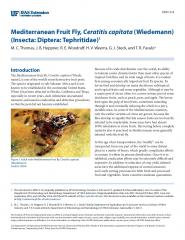Solitary Sugar Palm or Arenga pinnata is a monoecious feather palm of up to 20 m tall with a straight trunk that can be 30 - 65 cm in diameter. The trunk is covered with rough old leaf bases. Solitary sugar palm has a crown of large, pinnate leaves and an extensive root system. It is commonly grown in tropical Asia for many uses. Flowering stems are sources of drink and sugar from the sweet sap. It is also fermented into vinegar and wine. The apical bud is cooked as vegetable, or eaten raw. The leaves are also edible. The trunk pith, when grounded, can produce a sago-like flour that is used for cakes, noodles, and other dishes. The endosperm of young sugar palm fruit is cooked and known in West Java as kolang kaling or kaong in the Philippines. The roots can be a source of tea decoction that is used as relief for bladder problems. The leaf sheath is a source of gomuti or yonut fibre, a very strong and durable black fibre that is mainly used for making cables, marine work, thatching, upholstery, and brushes. Old woody leaf bases and the long leaves can be used for fuel. Young leaves, on the other hand, are sometimes used as cigarette paper. The roots are used as an insect repellent. Other common names are Sugar Palm, Arenga Palm, Areng Palm, Black-fibre Palm, Gomuti Palm, Aren, Enau, Irok, and Kaong.
Arenga pinnata is an evergreen Tree growing to 15 m by 10 m at a medium rate.
It is hardy to zone 10.
Suitable for: light , medium and heavy soils, prefers well-drained soil and can grow in heavy clay and nutritionally poor soils. Suitable pH: acid, neutral and basic soils and can grow in very acid and very alkaline soils.
It can grow in semi-shade or no shade. It prefers moist soil.
Industrial Crop: Fiber Management: Standard Minor Global Crop Other Systems: Multistrata Staple Crop: Sugar
A plant of the moist, lowland tropics, where it is found at elevations up to 1,400 metres. It grows best in areas where annual daytime temperatures are within the range 22 - 28c, but can tolerate 16 - 32c. It prefers a mean annual rainfall in the range 3,000 - 3,500mm, but tolerates 2,000 - 4,000mm. Prefers a deep fertile moisture-retentive but well-drained soil. Plants grow well in full sun, even when small. Prefers a pH in the range 6 - 7, tolerating 5 - 8. The plant usually produces its first flowers when around 10 - 12 years old, though it can flower as early as 5 - 6 years. Depending on altitude and temperature and to a lesser degree on factors such as soil fertility, climate and competing vegetation, the palms will stay in the rosette stage for 3.5 - 6 years, and then grow to full size in another 3 - 9 years. Usually after 5 - 6 years, the fibres can be collected for the first time and after that, every 2 years. When the palm begins flowering, tapping for the sweet sap can start, but farmers usually wait for the first male flowers. The sap is usually tapped only from male inflorescence stalks, because female inflorescences are said to produce sap of inferior quality, and the more fibrous stalk of the females requires extra effort to prepare. Usually, the closer to the ground the male inflorescence arises, the less sap it produces. One inflorescence can produce about 5 litres of sap a day. An inflorescence of sugar palm can be tapped for 1 - 2 months, and 2 - 4 inflorescences may be tapped at a time. Since sago, the starchy layer on the inner part of the trunk, is obtained only by cutting trees, it is usually the last product obtained;trees are usually cut for sago when they are more than 30 years old. The black roots are very strong, extending up to 10 metres from the stem and going as deep as 3 metres.
Habitatsoften as a result of human activity. Otherwise it prefers secondary forest at the border of primary rainforests. Often found on sites poor in nutrients and mesic sites such as denuded hillsides.
Resources
IN37100

EENY-214
Mediterranean Fruit Fly, Ceratitis capitata (Wiedemann)
(Insecta: Diptera: Tephritidae) 1https://edis.ifas.ufl.edu/pdffiles/IN/IN37100.pdfIN37100IN37100
EENY-214
EDIS - Electronic Data Information Source - UF/IFAS Extension
Mediterranean Fruit Fly, Ceratitis capitata (Wiedemann)
(Insecta: Diptera: Tephritidae) 1
